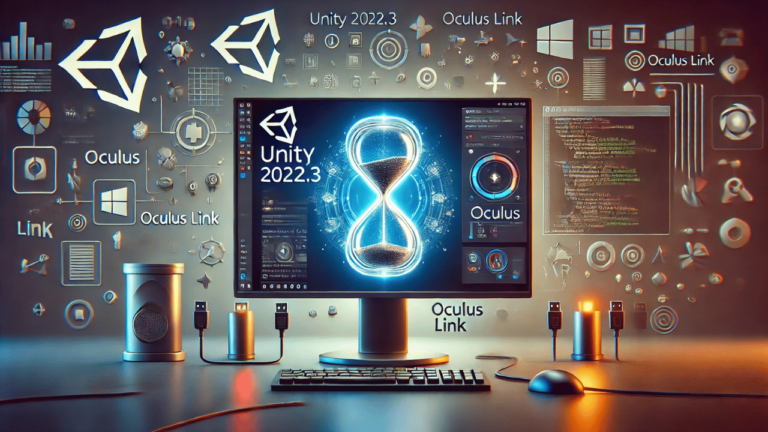If you’re a Unity developer using Oculus Link on Windows 11, you may have encountered frustrating issues such as the constant hourglass cursor. These problems, including Unity 2022.3 Oculus Link constant hourglass Windows 11, Unity 2022.3 Oculus Link stalling constant hourglass Windows 11, and Unity 2022.3 Oculus Link screen tearing constant hourglass Windows 11, can significantly disrupt your workflow. Whether you’re developing a VR game, testing a scene, or simply troubleshooting, these issues can prevent smooth development.
In this guide, we’ll walk you through the common causes and effective solutions for fixing these issues so you can get back to building without interruptions.
Understanding the Unity 2022.3 Oculus Link Constant Hourglass on Windows 11
What Is the Constant Hourglass Issue in Unity 2022.3?
The constant hourglass cursor is a common symptom of an application being unresponsive or stuck in a loading state. When you’re using Unity 2022.3 with Oculus Link on Windows 11, this issue can arise when the system is unable to properly communicate with the Oculus VR headset, causing Unity to freeze or become unresponsive. This results in a frustrating experience where you can’t interact with the editor or VR features as expected.
The Unity 2022.3 Oculus Link constant hourglass Windows 11 issue often happens during startup, scene loading, or VR testing sessions. It may also occur when switching between Unity and the Oculus interface. Let’s explore what could be causing this issue and how to fix it.
Common Causes of Unity 2022.3 Oculus Link Constant Hourglass Windows 11
Several factors may contribute to this problem:
- Outdated Drivers: Oculus Link depends on up-to-date software, including Oculus drivers and the Unity engine itself. If either is outdated, you might experience crashes or loading delays.
- High System Resource Usage: If your system is running low on CPU or GPU resources, Unity and Oculus Link can struggle to perform smoothly, resulting in the constant hourglass.
- Incompatible USB Cables: A poor-quality or incompatible USB cable can cause issues with the Oculus Link connection, leading to errors such as this.
- Windows 11 Compatibility: As a newer operating system, Windows 11 may not always be fully compatible with every VR-related driver or software configuration.
How to Fix Unity 2022.3 Oculus Link Stalling Constant Hourglass on Windows 11
Troubleshooting Unity 2022.3 Oculus Link Stalling
If you’re facing Unity 2022.3 Oculus Link stalling constant hourglass Windows 11, you’ll want to address this issue quickly to avoid interruptions in your development workflow. Stalling can occur during specific actions, such as when Unity tries to load a scene or when interacting with the Oculus headset.
Here are some potential solutions:
Update Your Oculus and Unity Software:
- Always make sure you’re running the latest versions of both Unity 2022.3 and the Oculus app on your Windows 11 machine. Updates often include performance improvements and bug fixes that may resolve stalling issues.
Free Up System Resources:
- Close unnecessary background applications that may be consuming CPU and RAM. Unity and Oculus Link require significant system resources, and running too many apps in the background can cause them to stall.
Check USB Port and Cable Quality:
- A poor connection can also lead to stalling. Ensure you’re using a high-quality USB 3.0 or USB-C cable with your Oculus headset. Also, try switching to a different USB port to see if the issue persists.
Adjust Unity Editor Settings:
- Try reducing the graphic settings or scene complexity in Unity. High-resolution textures or overly complex shaders can add strain to the GPU, leading to stalling during VR testing.
Resolving Unity 2022.3 Oculus Link Screen Tearing and Constant Hourglass on Windows 11
Screen Tearing in Unity 2022.3 Oculus Link
Another frustrating issue related to Unity 2022.3 Oculus Link is screen tearing, where the VR display appears disjointed or “torn,” particularly when there’s a mismatch between the VR headset’s refresh rate and the graphics card’s output.
When paired with the constant hourglass, screen tearing becomes even more annoying, especially during gameplay or scene transitions. Fortunately, there are several fixes to address these issues.
How to Fix Screen Tearing and Hourglass in Oculus Link on Windows 11
Enable V-Sync in Unity:
- V-Sync ensures that the frame rate of Unity matches the refresh rate of the Oculus headset, preventing screen tearing. Go to Edit > Project Settings > Quality, and make sure V-Sync is enabled.
Optimize Oculus Link Bitrate:
- If you’re using Oculus Link with a high bitrate, the system might struggle to maintain a consistent connection, especially if your hardware isn’t up to par. Try lowering the bitrate in the Oculus Debug Tool for smoother performance.
Update Graphics Drivers:
- Screen tearing can also be caused by outdated or incompatible GPU drivers. Make sure your NVIDIA or AMD drivers are up-to-date to ensure smooth performance and reduce tearing.
Adjust Unity’s Quality Settings:
- Lowering the resolution or texture quality in Unity can significantly reduce the GPU workload, which can help prevent both screen tearing and constant hourglass issues.
Preventing Future Issues: Tips for Smooth Unity and Oculus Link Integration on Windows 11
While you may have already fixed the Unity 2022.3 Oculus Link constant hourglass Windows 11 issue, it’s important to implement some best practices to avoid encountering similar problems in the future.
Regularly Update Software:
- Both Unity and the Oculus software receive frequent updates that fix bugs and optimize performance. Make sure you stay on top of these updates to prevent issues like stalling and screen tearing.
Monitor System Performance:
- Use performance monitoring tools to ensure that your system is running optimally. Tools like Task Manager (for Windows 11) or Unity Profiler can give you insights into which processes are consuming the most resources.
Use High-Quality Hardware:
Invest in a good-quality USB-C cable, fast SSD storage, and high-end GPU for VR development. Poor hardware can quickly lead to slow performance and connectivity issues, including the dreaded constant hourglass.
Test with Different Configurations:
- Test your Unity scenes and Oculus VR applications in a variety of configurations to identify any potential causes of issues. This includes experimenting with Unity’s graphics settings, Oculus Link bitrate, and VR resolution settings.
Conclusion
If you’re experiencing issues like Unity 2022.3 Oculus Link constant hourglass Windows 11, Unity 2022.3 Oculus Link stalling constant hourglass Windows 11, or Unity 2022.3 Oculus Link screen tearing constant hourglass Windows 11, don’t panic—these problems are solvable with the right troubleshooting steps. By keeping your software up-to-date, optimizing your system settings, and using quality hardware, you can significantly reduce the likelihood of encountering these annoying issues.
Remember to regularly check for Oculus updates and keep an eye on your Unity settings for optimal performance. These simple solutions will help you get back to building your VR projects without interruptions.
FAQs
What causes the constant hourglass issue in Unity with Oculus Link?
The issue often arises from outdated software, system resource limitations, or a faulty USB connection.
How can I prevent screen tearing in Unity with Oculus Link?
Enabling V-Sync in Unity and optimizing your Oculus Link bitrate can prevent screen tearing.
Does Windows 11 affect Oculus Link performance in Unity?
Yes, Windows 11 may cause compatibility issues with VR-related software. Ensure your system is fully updated to prevent problems.
Can I improve Unity performance in VR?
Yes, lowering Unity’s graphics settings and optimizing your system resources can help improve VR performance.
What’s the best USB cable for Oculus Link?
Use a USB 3.0 or USB-C cable that supports high data transfer rates to ensure a stable connection with Oculus Link.


